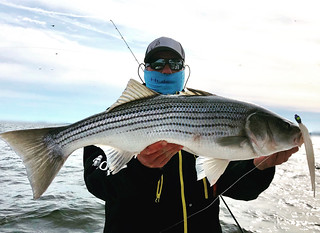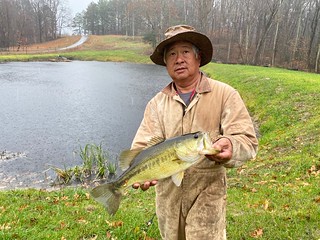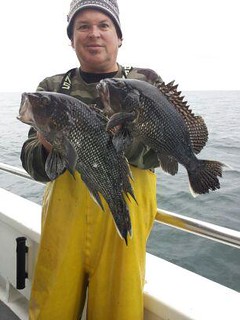Maryland Fishing Report – Dec. 4

Mike Crocetti made the trip to Tuckahoe Lake to enjoy a beautiful day and a chance to catch and release a nice chain pickerel. Photo courtesy of Mike Crocetti
There is no doubt the hand of winter is passing over Maryland. Despite colder weather, there is plenty of fun fishing to be had from the sheltered shores of the many ponds, lakes, reservoirs, creeks, and rivers throughout Maryland. The preseason stocking of trout has begun, and other fish such as chain pickerel are active and waiting for you.
The Sport Fisheries Advisory Commission recently created an annual recreational fisheries achievement award, to be given once a year. This is a great opportunity to recognize someone you know who goes that extra distance to volunteer their services to help with the promotion and conservation of our recreational fisheries resources in Maryland. For more information and to nominate someone, find everything you need on the Department of Natural Resources website.
Forecast Summary: Dec. 4 – Dec. 10:
As we approach the end of striped bass season in mid-December, Chesapeake Bay temperatures continue to drop. The cool weather has reduced the water temperature of upper Bay mainstem and rivers to the mid 40s, and from Annapolis south to the Virginia state line to the upper 40s. This cooling will continue through the next week. Warmest waters continue to be found in the bottom quarter of the water column from the mouth of the Patuxent River down to the Virginia state line.
Anglers should focus on prime habitat areas for larger concentrations of baitfish and hungry gamefish as they migrate to their winter holding areas. As always, make sure to focus on moving water periods for best results.
Expect normal flows from most of Maryland’s rivers and streams until early next week when they will begin to rise as a result of the rains beginning Monday and Tuesday. There will be above average tidal currents Sunday through Tuesday as a result of the upcoming full moon Dec. 12. Bay surface salinities are largely back to normal conditions.
Expect normal water clarity in Maryland Bay waters most of the week with potentially reduced water clarity early next week from predicted rains. To see the latest water clarity conditions, check Eyes on the Bay Satellite Maps.
For the full weekly fishing conditions summary and more detailed and up-to-date fishing conditions in your area of the bay, be sure to check out Click Before You Cast. You can now get regular updates on Maryland’s waters and the creatures that call them home sent to your inbox with our new Eyes on the Bay newsletter. Sign up online.
Water temperatures in the lower Susquehanna River are in the low 40s now, and striped bass fishing has just about come to a halt. Fishing for a mix of channel, flathead, and blue catfish has been good for those seeking some fishing action. Yellow perch are also moving into the tidal rivers and creeks. Fresh cut bait of any kind will catch the catfish, and minnows and small lures fished close to the bottom work well for yellow perch.
It has been slim pickings for those trolling or jigging the channel edges. The deep channel edges off Podickory Point and the mouth of the Magothy River are two popular places to fish. Most anglers are pulling umbrella rigs with a bucktail dressed with a sassy shad as a trailer, behind heavy inline weights to get them close to the bottom where fish are suspended. Those jigging are targeting the same areas plus the deeper sections of the Bay Bridge rock piles, piers, and concrete abutments. Many have switched to heavier jigs in order to reach the depths where the striped bass are suspended.
Colder water is causing striped bass to slow their metabolism down, and they often stop feeding do so only sparingly as water temperatures drop into the low 40s. They tend to be holding in the depths of the channels, where they are finding slightly warmer water temperatures. It is not uncommon to find them stacked up and unwilling to strike a jig or trolled lure. In fact, when jigging over a concentration of fish, you may find you snag as many as actually take a jig.
White perch are offering good fishing when you can find them suspended over hard bottom in the deeper areas of the Bay. The rock piles at the Bay Bridge are a good place to look for large white perch, using a heavy jig or sinker with a dropper fly or two when using a sinker.
Fishing for striped bass is focused on targeting the deeper channel edges by jigging or trolling. Popular places to fish are the east side of the shipping channel near Buoy 83, down to the False Channel at the mouth of the Choptank River. It takes a lot of weight to get down to the fish so heavy inline weights are required when trolling. Umbrella rigs are the most popular item being trolled this week, usually with a Storm Shad type trailer or a bucktail dressed with a sassy shad in chartreuse or white.
Jigging is a fall tradition and there is still some action to be had along the shipping channel edges on both sides of the middle Bay. Many anglers have moved up to ¾-ounce and 1-ounce jig heads adorned with skirts and soft plastics up to 10 or longer in shades of pearl, chartreuse, and white, often dipped in red-colored garlic scent. Much of the action is occurring at 30 feet or deeper, and it can be fickle.
White perch offer a fun diversion and once they are found suspended close to the bottom can offer plenty of action. Some of the traditional places to look include holes off Kent Island, the mouth of Eastern Bay, and the mouths of the Choptank, Little Choptank, Severn, and West rivers. A metal jig with a dropper fly above or a bottom rig baited with pieces of bloodworm work well.

Angelina Watts holds up a beautiful speckled trout caught while fishing with her dad. Photo by Rich Watts
Some of the best and most consistent striped bass fishing in Maryland waters is found here. The waters around the Point Lookout area are just a little warmer than farther north. The striped bass are suspended close to the bottom at depths of 30 feet to 40 feet along the major channel edges.
The shipping channel edges along the west side of the Bay and the mouth of the Patuxent and Potomac rivers are excellent places to find striped bass, and even a speckled trout now and then. The east side of the shipping channel near the HS Buoy and south past Buoy 72 are also good places to jig or troll.
Most are jigging with ¾-ounce to 1-ounce skirted jigs with 8-inch to 10-inch soft plastics in shades of chartreuse, pearl with sparkles, and white. Those that are trolling are using umbrella rigs behind heavy inline weights to get close to the depths where the fish are holding. Various Storm type shads and bucktails dressed with sassy shads are popular trailing lures.
Those seeking out a little different fishing fun are probing the depths near the mouths of several tidal rivers. Large white perch are being found in about 40 feet of water in the lower Patuxent River. Fishing with a two-hook bottom rig baited with pieces of bloodworm is a favored way to fish for them. Similar action is found near the mouth of the Nanticoke River and Tangier Sound. Yellow perch are providing an increasing amount of fishing opportunities in many of the tidal rivers and can be caught by fishing small minnows or casting small lures close to the bottom.
Trout stocking has begun once again providing additional incentive for anglers to fish during these colder months. Thousands of trout were stocked in the Delayed Harvest section of the Youghiogheny and the put-and-take waters of Blair Valley and Greenbrier lakes this week. Be sure to check the trout stocking site; better yet, sign up for the email news service to receive notice of trout stockings.
Colder water temperatures in the upper Potomac River have forced smallmouth bass to lie in some of the deeper holes in the river. Fishing with live minnows or crayfish close to the bottom can be a good tactic to entice some of these large smallmouth bass to pick up a bait. Working jigs and tubes slow and close to the bottom can also work, but the bite will be very subtle. Walleye tend to do well in the colder water and are active in many of the deeper holes and current breaks.
Walleye are also a favorite fish to target at Deep Creek Lake along its steep rocky edges. Casting small crankbaits and diving jerk baits during the early morning or late evening hours from shore offers good opportunity. Drifting live minnows is another good way to catch them along with large yellow perch. The lower Susquehanna River also has a population of walleye in what are considered tidal waters.
Largemouth bass are feeling the cold and have retreated to the deeper waters at the base of drop-offs. Fishing slowly with blade lures, jigs and grubs close to the bottom is a good tactic. The pickup will be very subtle, so watch for the slightest movement in the line. On sunny days they may be found in shallower areas seeking a little warmth from the sun, lipless crankbaits, spinnerbaits, and crankbaits can be good choices to fish.
Crappie are schooled up near deep structure and will be holding there. Bridge piers, sunken wood, fallen treetops and marina docks are great places to look for them. Fishing a minnow or small jig close to structure can pay off in a nice catch of good-eating crappie.
Chain pickerel love cold water and they are widely spread throughout Maryland’s small ponds, larger reservoirs, and tidal waters. They will be oriented near any kind of structure they can find, patiently waiting there to ambush anything that might swim by. Often the largest chain pickerel will be found out in more open and deeper water, sitting tight to structure.
Despite cooling waters, catfish are active this week and can provide plenty of fun fishing in a variety of situations. Bank fishing can be a comfortable pastime during these colder times along the tidal rivers. The tidal Potomac, Patuxent, and Nanticoke rivers contain large numbers of blue catfish, which make for fine eating. Channel catfish can be found in most every tidal river of the Chesapeake Bay as well as the upper Potomac River and a few select reservoirs such as Piney Run in Carroll County. Flathead catfish are numerous in the Conowingo Dam Pool and can grow to some very large sizes there. Smaller flathead catfish can be found in the lower Susquehanna River and the upper Potomac. Fresh cut bait is one of the more popular baits for all three species, clam snouts work well and some have good luck with pieces of chicken breast, livers or gizzards.
Northern snakeheads are feeling the chill and the loss of the thick grass where they lurk during the warmer months. They can now be found in more open waters, and covering those areas with chatterbaits or popping corks and bobbers with a large minnow trailing is an excellent tactic. Sunny afternoons often cause northern snakeheads to be more active. The tidal Potomac and feeder creeks, the Patuxent River, the Nanticoke, Little Choptank, and the tidal creeks of lower Dorchester County are good places to find them.
Coastal fishermen continue their wait for migrating striped bass from more northern waters, and there is some indication that we may be getting closer to that event. These large striped bass are following the southern migration of menhaden, schools of which are being spotted off the beaches of Maryland. Striped bass will follow the food so it is hoped they are not far behind.
There is some striped bass action at the inlet and Route 50 Bridge area providing some action for those working jigs. Most are below the 28-inch minimum but they offer some fun fishing opportunities. Tautog are present along the rocks and bulkhead areas inside the inlet and can be caught on sand fleas or pieces of green crab. A few keepers are being caught but the abundant smaller fish are providing plenty of fun.
Fishing for sea bass and tautog continues to be good this week at the various nearshore and offshore wreck and reef sites. Limit catches of sea bass are common with a mix of porgies, flounder, and bluefish occurring at times. Captains report that some sites are covered up with spiny dogfish, so pulling up anchor and moving to another fishing location may be necessary.
Those heading out to the canyons to fish deep for swordfish and bigeye tuna continue to have good results and some impressive fish are being brought back to the docks. Deep drop fishing for tilefish can also offer some late season fishing.
“Many of the most highly publicized events of my presidency are not nearly as memorable or significant in my life as fishing with my daddy.” — Jimmy Carter
Maryland Fishing Report is written and compiled by Keith Lockwood, Maryland Department of Natural Resources fisheries biologist.
Click Before You Cast is written by Tidewater Ecosystem Assessment Director Tom Parham.
This report is now available on your Amazon Echo device — just ask Alexa to “open Maryland Fishing Report.”




